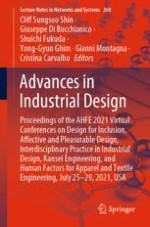This book addresses current research trends and practice in industrial design. Going beyond the traditional design focus, it explores a range of recent and emerging aspects concerning service design, human–computer interaction and user experience design, sustainable design, virtual and augmented reality, as well as inclusive/universal design, and design for all. A further focus is on apparel and fashion design: here, innovations, developments and challenges in the textile industry, including applications of material engineering, are taken into consideration. Papers on pleasurable and affective design, covering studies on emotional user experience, emotional interaction design and topics related to social networks, are also included. Based on the AHFE 2021 International Conferences on Design for Inclusion, Interdisciplinary Practice in Industrial Design, Affective and Pleasurable Design, Kansei Engineering, and Human Factors for Apparel and Textile Engineering, held virtually on 25–29 July 2021, from USA, this book provides, researchers and professionals in engineering, design, human factors and ergonomics, human computer interaction and materials science with extensive information on research trends, innovative methods and best practices, and is expected to foster collaborations between experts from different disciplines and sectors.
